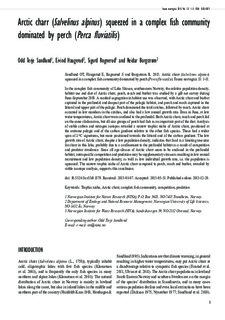| dc.description.abstract | In the complex fish community of Lake Skasen, southeastern Norway, the relative population density, habitat use and diet of Arctic charr, perch, roach and burbot was studied by a gill net survey during June-September 2010. A marked segregation in habitat use was observed, with Arctic charr and burbot captured in the profundal and deepest part of the pelagic habitat, and perch and roach captured in the littoral and upper part of the pelagic. Perch dominated the total catches, followed by roach. Arctic charr occurred in low numbers in the catches, and also had a low annual growth rate. Even in June, at low water temperatures, Arctic charr were confined to the profundal. Both Arctic charr, roach and perch fed on the same cladocerans, but all size groups of perch had fish as an important part of the diet. Analysis of stable carbon and nitrogen isotopes revealed a narrow trophic niche of Arctic charr, positioned at the extreme pelagic end of the carbon gradient relative to the other fish species. These had a wider span of δ13C signatures, but more positioned towards the littoral end of the carbon gradient. The low growth rate of Arctic charr, despite a low population density, indicates that food is a limiting resource for charr in this lake, probably due to a confinement to the profundal habitat as a result of competition and predator avoidance. Since all age-classes of Arctic charr seem to be enclosed in the profundal habitat, intraspecific competition and predation may be supplementary stressors resulting in low annual recruitment and low population density, as well as low individual growth rate, i.e. the population is squeezed. The narrow trophic niche of Arctic charr compared to perch, roach and burbot, revealed by stable isostope analysis, supports this conclusion. | nb_NO |

